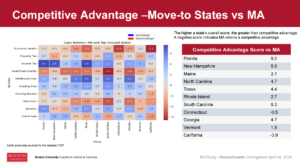Thoughts on Outmigration and Competitiveness
Thoughts on Out Migration and Competitiveness

A picture is worth a thousand words. This heatmap lays out the key areas Massachusetts’ needs to focus on to stem net outmigration and improve its competitiveness relative to other move-to states. This analysis shows the competitive advantage the 11 top outbound states enjoy over Massachusetts based on 10 key drivers. The blue (higher numbers) indicate that the competitor state is outperforming Massachusetts, while the red (negative numbers) indicate Massachusetts is outperforming the competitor state. The higher the number, the greater the move-to states competitive advantage.
Massachusetts outperforms these top designation states in only three measures – healthcare quality, education, and overall economic conditions. We perform weakest in three measures – housing cost, healthcare costs and income taxes and lag other states in the remaining categories.
Lawmakers are laser focused in attempting to address the housing cost crisis. There is a housing bond bill pending in the legislature that would provide $4.1 billion in additional resources to grow the supply of housing. The recently enacted MBTA Communities Act requires any municipality serviced by the public transit system to create a multi-family housing zone. The notion is to facilitate the building of more housing, especially housing at a more affordable price point and with easy access to public transportation to ease traffic congestion. Other initiatives to assist potential homebuyers are also being considered.
This is important work. But as the BU Study indicates, the causes of outmigration are multifactorial and focusing on housing alone won’t stem the state’s growing outmigration problem.
The two most popular destination states for Massachusetts residents are Florida and New Hampshire. Unsurprisingly, Florida wins in the weather category but the Sunshine states also outperforms Massachusetts on several other measures – property and income taxes, healthcare and housing costs, and crime rate. Similarly, New Hampshire has better scores on income taxes (NH doesn’t tax income), healthcare and housing costs, housing burden, and its crime rate. Both states are within striking distance of Massachusetts on economic health – New Hampshire is only .01 points below Massachusetts and Florida’s score is only .02 points below. The remaining 8 other states also outperform Massachusetts on housing and healthcare costs, and individual states beat Massachusetts scores on other measures. Only California and Connecticut performed worse and still attracted Massachusetts residents. California’s tech sector may still be a draw particularly for the college educated, high earning 25-34 year olds and no doubt the weather is certainly better. For Connecticut, it may simply be that its proximity allows people to move there and retain ties to friends and families in Massachusetts or it could just be a one-year anomaly.
As policy makers work to make Massachusetts more affordable and competitive, we need to make progress on the measures for which we underperform, and protect the three areas that are providing a competitive edge. With regard to economic health, remote work and high commercial property vacancies could hurt our economic underpinnings and action must be taken to mitigate both or risk losing our high score. Education advancements are being jeopardized by proposals to eliminate standardized tests that measure student progress (MCAS) and should be rejected. Healthcare labor shortages and high costs of care impede access to necessary care and must be addressed to maintain our high quality healthcare relative to other states.
This comprehensive BU migration study serves as an important reminder that other states are not standing still in the competition to attract businesses and residents. Massachusetts is going to have to up its game to compete.



